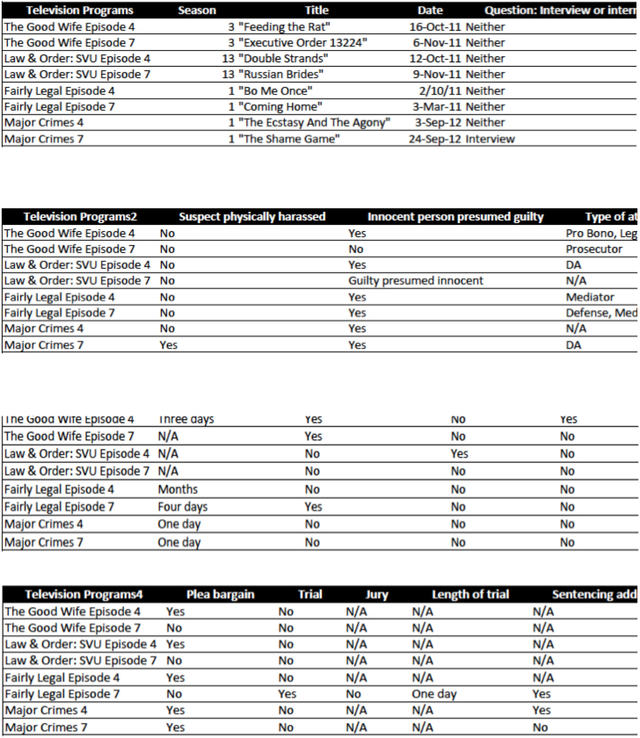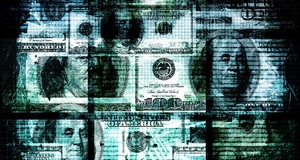From Elon Journal of Undergraduate Research in Communications VOL. 4 NO. 1The Portrayal of the American Legal System in Prime Time Television Crime DramasV. Discussion and ConclusionThrough this study, it can be concluded prime time television crime dramas portray suspects’ treatment fairly accurately, as the majority of the studied episodes showed police officers, detectives or interviewers professionally interviewing suspects. Additionally, the overwhelming majority of interviewers did not physically harass suspects in the questioning room. However, because many of the episodes included instances where innocent suspects were presumed guilty, there seems to be a disconnect between the fair treatment of suspects and the guilty statuses police officers, detectives or interviewers assign to them. This contradiction relates back to the literature, which states, “In the case of innocent suspects, one would hope that investigators would periodically reevaluate their beliefs. Over the years, however, a good deal of research has shown that once people form an impression, they unwittingly seek, interpret and create behavioural data that verify it.”29 It seems that although police officers, detectives and interviewers in television programs ask questions politely, they rarely reevaluate their initial impressions of suspects, which in turn results in several wrongful detainments. Within this study, it can also be concluded prime time television crime dramas do not accurately portray the case building process. Because the majority of the episodes showed attorneys building their cases within five days, it seems crime dramas inaccurately depict the amount of time it takes attorneys to collect and review evidence, meet and interview their clients, research background information and select witnesses. Finally, it can be concluded that prime time television crime dramas do not accurately portray trial length. Before a defendant reaches trial, he or she must attend a preliminary hearing, which requires the prosecutor and defense attorney to present evidence, challenge whether or not there is enough information to suspect a crime has been committed and argue whether the defendant committed the crime. If charges are brought forward, a defendant must then attend the arraignment where he or she is formally informed of the charges he or she is facing. Further, the defendant is given the opportunity to enter a plea. Then, the prosecutor and defense attorney must complete the discovery and motion processes, which require they both exchange information about the case. Finally, a defendant can submit a plea bargain, which means he or she agrees to plead guilty to the said charges in order to avoid trial. If and when a defendant does reach trial, a jury must be present unless the defendant has waived his or her right to a trial by jury or unless the case addresses a certain misdemeanor where a bench trial is more appropriate.30 Because many crime dramas fail to mention or show any of these processes, it is clear they do no accurately present the length of a trial.In essence, it can be concluded from this study that tendencies of exaggeration and inaccuracy in prime time network television crime dramas exist through the portrayal of suspects’ treatment, the case building process and trial length. These inaccuracies and exaggerations lead viewers to misinterpret the processes of the United States legal system. This study cannot make any generalized conclusions though. It only included episodes from four different crime drama television programs, so it cannot be applied to all crime drama television programs. Only two episodes per program were selected, so the results could have been different if other episodes within the same seasons had been selected. Further, this study cannot be used to describe The Good Wife, Law & Order: SVU, Fairly Legal or Major Crimes in respect to their accurateness as a whole—it can only be used to describe these television programs to a certain point within a specific time period. Because of these things, this study should serve as a pilot for a more extensive study concerning these issues. AcknowledgmentsThis author is thankful to Dr. Copeland at Elon University for his supervision and advice, without which this article could not be published. The author also appreciates numerous reviewers who helped to revise this article. References“Casey Anthony Trial: Timeline of Key Events in the Murder Trial of the Florida Mother,” ABC News, July 6, 2012, http://abcnews.go.com/US/casey-anthony-trial-timeline-key-events/ story?id=13990853&page=3#.UKhS94VrZr0 (Retrieved on November 17, 2012). “CBS Primetime TV Schedule,” CBS, n.d., http://www.cbs.com/schedule/ (September 17, 2012). Cressey, Donald R. “Criminological Research and the Definition of Crimes,” American Journal of Sociology 56 (1951): 547. “Crime Most Common Story on Local Television News,” Kaiser Family Foundation, March 12, 1998, http://www.kff.org/mediapartnerships/1374-crime.cfm (September 17, 2012). Graybow, Martha. “Prosecutors See ‘CSI Effect in White-Collar Cases,” Reuters, September 24, 2005, http://www.redorbit.com/news/general/250029/prosecutors_see_csi_effect_in_whitecollar_cases/ (October 23, 2012). Kassin, Saul M., et al. “Interviewing suspects: Practice, science, and future directions,” Legal and Criminology Psychology 15 (2010): 39-41. King, Nancy Jean. “The American Criminal Jury,” Law and Contemporary Problems, 62 (1999): 41, 59. Lawson, Tamara F. “Before the Verdict and Beyond the Verdict: The CSI Infection Within Modern Criminal Jury Trials,” Loyola University Chicago Law Journal 41 (2009): 121. Legal Information Institute, s.v. “Legal Systems.” “Physical Harassment,” SC Budget and Control Board, n.d., http://ohrweb.ohr.state.sc.us/OHR/antiharassment/Page15.htm (November 17, 2012). Roane, Kit R. “The CSI Effect,” U.S. News & World Report, April 17, 2005, Tech section, 1-2. “Schedule,” NBC, n.d., http://www.nbc.com/schedule/ (September 17, 2012). “Schedule,” TNT, n.d., http://www.tntdrama.com/schedule/?startDate=10/1/2012&timeZone= (September 30, 2012). “Schedule,” USA, n.d., http://www.usanetwork.com/series/fairlylegal/theshow/episodeguide/episodes/s2_rippleofhope/index.html (September 30, 2012). Stelter, Brian. “Casey Anthony Verdict Brings HLN Record Ratings,” New York Times, July 6, 2011, http://mediadecoder.blogs.nytimes.com/2011/07/06/casey-anthony-verdict-brings-hln-record-ratings/ (September 17, 2012). “Top 20 Network Primetime Series: Oct. 8-14, 2012,” Nielsen Television (TV) Ratings for Network Primetime Series, n.d., http://www.zap2it.com/tv/ratings/zap-weekly-ratings,0,7508066.htmlstory (October 23, 2012). “Top Tens & Trends of Television,” Nielsen, August 20, 2012, http://www.nielsen.com/us/en/insights/top10s/television.html (September 30, 2012). “Trial Juror’s Handbook,” New York State Unified Court System, n.d., www.nyjuror.gov (October 23, 2010). Tyler, Tom R. “Viewing CSI and the Threshold of Guilt: Managing Truth and Justice in Reality and Fiction,” The Yale Law Journal 115 (2006): 1052. “Violent Crime,” Federal Bureau Investigation, n.d., http://www.fbi.gov/about-us/cjis/ucr/crime-in-the-u.s/2010/crime-in-the-u.s.-2010/violent-crime/violent-crime (September 17, 2012). “What are some common steps of a criminal investigation and prosecution?” National Crime Victim Law Institute, 2012, http://law.lclark.edu/live/news/5498-what-are-some-common-steps-of-a-criminal/law/ centers/national_crime_victim_law_institute/for_victims/answers/ (October 23, 2012). Willing, Richard. “‘CSI effect’ has juries wanting more evidence,” USA Today, August 5, 2004, News section, http://usatoday30.usatoday.com/news/nation/2004-08-05-csi-effect_x.htm (October 23, 2012). Young Lawyer’s Section, Bar Association of the District of Columbia, 4th ed., s.v. “Criminal Jury Instructions for the District of Columbia.” Endnotes1.) “Violent Crime,” Federal Bureau Investigation, n.d., http://www.fbi.gov/about-us/cjis/ucr/crime-in-the- u.s/2010/crime-in-the-u.s.-2010/violent-crime/violent-crime (September 17, 2012). 2.) “Crime Most Common Story on Local Television News,” Kaiser Family Foundation, March 12, 1998, http://www.kff.org/mediapartnerships/1374-crime.cfm (September 17, 2012). 3.) Brian Stelter, “Casey Anthony Verdict Brings HLN Record Ratings,” New York Times, July 6, 2011, http://mediadecoder.blogs.nytimes.com/2011/07/06/casey-anthony-verdict-brings-hln-record-ratings/ (September 17, 2012). 4.) “CBS Primetime TV Schedule,” CBS, n.d., http://www.cbs.com/schedule/ (September 17, 2012). 5.) “Schedule,” NBC, n.d., http://www.nbc.com/schedule/ (September 17, 2012). 6.) “Schedule,” USA, n.d., http://www.usanetwork.com/series/fairlylegal/theshow/episodeguide/episodes/s2_rip- pleofhope/index.html (September 30, 2012). 7.) “Schedule,” TNT, n.d., http://www.tntdrama.com/schedule/?startDate=10/1/2012&timeZone= (September 30, 2012). 8.) Tamara F. Lawson, “Before the Verdict and Beyond the Verdict: The CSI Infection Within Modern Criminal Jury Trials,” Loyola University Chicago Law Journal 41 (2009): 121. 9.) Black’s Law Dictionary, 2nd ed., s.v. “Crime.” 10.) Legal Information Institute, s.v. “Legal Systems.” 11.) Tamara F. Lawson, “Before the Verdict and Beyond the Verdict,” 128-129. 12.) “Top 20 Network Primetime Series: Oct. 8-14, 2012,” Nielsen Television (TV) Ratings for Network Pri- metime Series, n.d., http://www.zap2it.com/tv/ratings/zap-weekly-ratings,0,7508066.htmlstory (October 23, 2012). 13.) Kit R. Roane, “The CSI Effect,” U.S. News & World Report, April 17, 2005, Tech section, 1-2. 14.) Tom R. Tyler, “Viewing CSI and the Threshold of Guilt: Managing Truth and Justice in Reality and Fiction,” The Yale Law Journal 115 (2006): 1052. 15.) Young Lawyer’s Section, Bar Association of the District of Columbia, 4th ed., s.v. “Criminal Jury Instructions for the District of Columbia.” 16.) Kit R. Roane, “The CSI Effect,” 1-2. 17.) Tamara F. Lawson, “Before the Verdict and Beyond the Verdict,” 132. 18.) Richard Willing, “‘CSI effect’ has juries wanting more evidence,” USA Today, August 5, 2004, News sec- tion, http://usatoday30.usatoday.com/news/nation/2004-08-05-csi-effect_x.htm (October 23, 2012). 19.) Martha Graybow, “Prosecutors See ‘CSI Effect’ in White-Collar Cases,” Reuters, September 24, 2005, http://www.redorbit.com/news/general/250029/prosecutors_see_csi_effect_in_whitecollar_cases/ (October 23, 2012). 20.) Nancy Jean King, “The American Criminal Jury,” LAW & CONTEMP. PROBS 62 (1999): 41, 59. 21.) Tamara F. Lawson, “Before the Verdict and Beyond the Verdict,” 127. 22.) Tamara F. Lawson, “Before the Verdict and Beyond the Verdict,” 124-125. 23.) “Top Tens & Trends of Television,” Nielsen, August 20, 2012, http://www.nielsen.com/us/en/insights/top10s/television.html (September 30, 2012). 24.) Saul M. Kassin et al., “Interviewing suspects: Practice, science, and future directions,” Legal and Criminology Psychology 15 (2010): 39. 25.) “Physical Harassment,” SC Budget and Control Board, n.d., http://ohrweb.ohr.state.sc.us/OHR/antiharass- ment/Page15.htm (November 17, 2012). 26.) Saul M. Kassin et al., “Interviewing suspects,” Legal and Criminology Psychology 15 (2010): 41. 27.) “Casey Anthony Trial: Timeline of Key Events in the Murder Trial of the Florida Mother,” ABC News, July 6, 2012, http://abcnews.go.com/US/casey-anthony-trial-timeline-key-events/story?id=13990853&page=3#. UKhS94VrZr0 (November 17, 2012). 28.) “Trial Juror’s Handbook,” New York State Unified Court System, n.d., www.nyjuror.gov (October 23, 2010). 29.) Saul M. Kassin et al., “Interviewing suspects,” Legal and Criminology Psychology 15 (2010): 41. 30.) “What are some common steps of a criminal investigation and prosecution?” National Crime Victim Law Institute, 2012, http://law.lclark.edu/live/news/5498-what-are-some-common-steps-of-a-criminal/law/centers/ national_crime_victim_law_institute/for_victims/answers/ (October 23, 2012). Appendix: Coding Sheets
Suggested Reading from Inquiries Journal
Inquiries Journal provides undergraduate and graduate students around the world a platform for the wide dissemination of academic work over a range of core disciplines. Representing the work of students from hundreds of institutions around the globe, Inquiries Journal's large database of academic articles is completely free. Learn more | Blog | Submit Latest in Business & Communications |





















